Wonderbras for Men, Pt. II ~ More on Codpiece Look and peep at history of men's underwear....
***
Notes: Still sure to offend some, and still rated Mature for explicit talk of "packages", images of racy men's underwear, nude Michelangelo’s David, nude Iggy again, and a Victorian photograph of nude men.
Again, there are loads of images to plague dial-up viewers. Images in this post are NOT links (so don’t wear out your clicking finger trying to make the guys bigger).
The first section will survey the history of men’s underwear, continuing with the discussion of the way underwear presents men’s genitals.
Section I. [European] Men’s Underwear.
In antiquity, Roman and Greek men, if they wore underwear at all, wore something of the loin cloth variety. Very little antique underwear exists even from more recent centuries, the garments passed on until they wore out and became rags. But, by the Middle Ages, judging from surviving texts and illustrations, women were wearing shifts* and men were wearing underdrawers, braies, from which came “breeches”.
*Women’s drawers wear not worn until the early 19th century, prompted by the clingy, form-fit style of Empire fashion. These were truly drawers, the pant legs open at the crotch for accessibility when using the toilet. Drawers continued to be open at the crotch for most of the 19th century, partially explaining the scandal of the can-can.
Medieval braies of the 13th century looked like boxer shorts, falling to the knee, with drawstring waists, which were then rolled a few times for comfort, and to bring the crotch to the right level. The inseams, except for the part near the crotch, were finished off open. This is clearly seen in prints.
The advantages of this were several. When peeing, the split inseam allowed a man to pull out his penis without taking down the braies. The split inseams also meant the man could wrap the leg panels more closely over his upper legs before tucking them down into his hose. A better fit in the legs meant there wasn’t a lot of excess linen hanging out of the tops of the hose.
The hose were tied to laces on the waistbands of the braies. Working outside in hot weather, stripped to their braies, men could tie up the ends of the legs with the laces at the waist, making the braies as short as they wished.
Braies have continued to be worn little changed ever since. Frodo, in the Cirith Ungol scene, appears to be wearing linen braies, the drawstring waist just visible above his breeches. That would make sense, since it is noted in the book that Sam, making sure he has plenty of everything, has packed "extra linen", ready to be produced when called for [by Frodo]. That could mean shirts, but in the scene in which Frodo's Moria wound is dressed, he's wearing a jacket over his worn tunic, under which is the mithril corselet. Under that is a shirt of soft leather worn next to the skin. No mention is made of additional linen in this detailed desciption of his upper clothing, so I am assuming the "extra linen" refers to braies.
Here are some illustrations showing the split-inseamed braies, worn alone, or tucked into split hose.
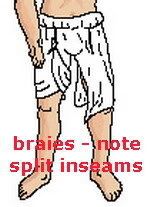
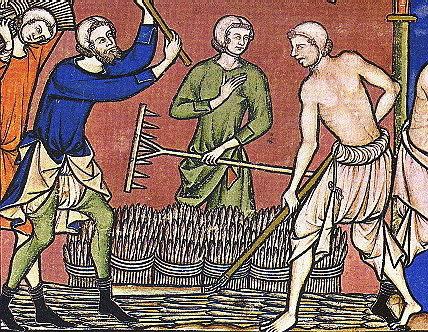
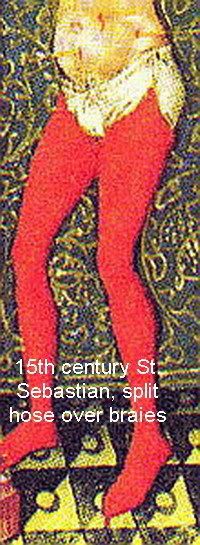
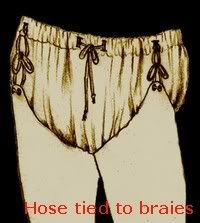
Replicas of split hose with braies tucked in, hose tied to doublet:
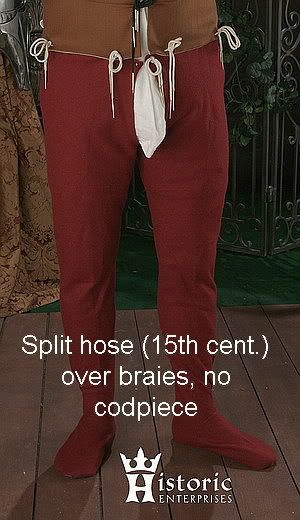
Braies were not always worn in the 13th century, an era when men’s tunics were well below the knee. This blown-up tiny image comes from a Book of Hours, showing a peasant man and woman warming themselves before the fire. They are quite naked under their clothes.
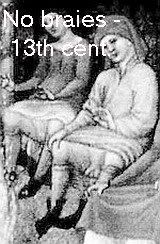
As the years went on, fashions changed. Men’s tunics became shorter. And shorter. Underneath, there was no fabric covering the crotch except the braies. If the man did not wear braies, he was naked above his hose.
I found the fascinating historical note below here.
Late-14th c fashions for dandies raised the hemlines to the ballocks, and early 15th c saw the first public exposure of the male crotch beneath the tunic. This trend forced the chaussers to invent the one-piece or joined hose. There is a turn-of-the-century admonition by an English bishop against men who sit splay-legged, exposing themselves; the implication is that they have purposefully chosen to omit wearing braies for shock value, but it may merely indicate outrage at the public display of the underpants.
At this point or soon after, the joined hose are no longer tied to the waistband, as mentioned above.
It should be noted that the rise of joined hosen did not eradicate the older, simpler style of separate hosen. As late as 1460 there is clear evidence in manuscripts of separate hosen worn by a member of the middle class. Obviously joined hosen, with the difficulties in tailoring and susceptability to bursting at the seat seams, were unpractical for the laboring class altogether.
Between the 14th and 15th century fashionable hose began to be made joined from the crotch to the back, but open in the front (for convenience), covered by a triangular panel, essentially a fly. Also, as more and more leg was being seen, even the buttocks, the braies became smaller and more fitted.
Here are some 14th and 15th century braies, also some joined hose with the front panel (historical replica).
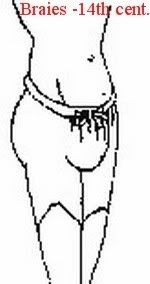
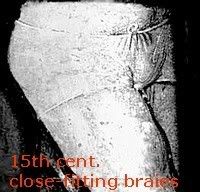
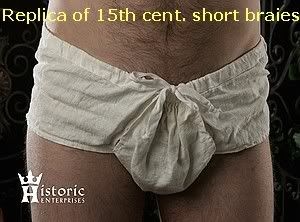
The image below shows split hose tied to a doublet, braies beneath. It was not dated, but I’m guessing it’s just before joined hose became the style. The 15th century split hose in the photo of historical replicas above are also tied to a doublet, so I will assume this image is from the 15th century.
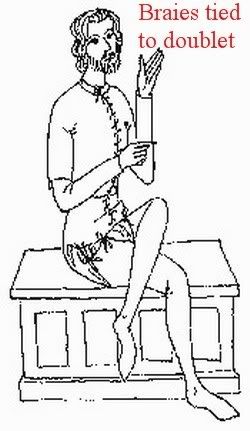
The triangular piece covering the crotch eventually came into general use.
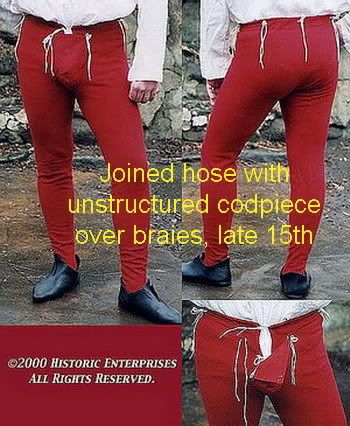
When tunic hems rose higher than the triangular piece, it began to receive fashionable attention. It might be trimmed, or be made of a contrasting colour. The pieces might have been sewn in a manner that made them more pouch-like, too. Already hose and braies had long been cut on the bias for better, closer fit. The ones pictured below seem to have a snug, supportive fit:
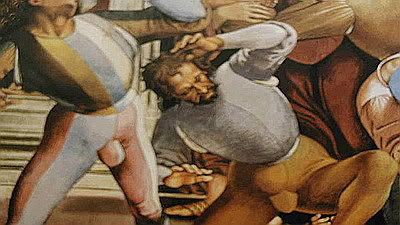
In this 15th century Renaissance painting, the cloth codpieces do seem to have had a pouch-like shape, very much like the “contour pouch”-style underwear I posted yesterday. Any braies worn under such close-fitting hose had to fit well, unlike the big, loose-fitting braies of previous centuries.
Modern equivalents of "soft codpiece" underwear (the last, I suspect, has a c-ring device):
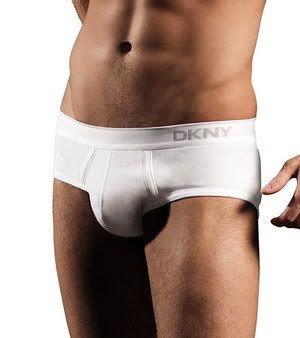
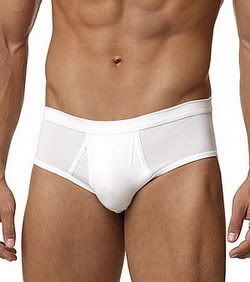

With the 16th century came the true “codpiece” - a structured cover for the penis and scrotum, resembling an athletic cup to start with, growing to a stiff, cotton-stuffed erection by mid-century.
Here are some examples from art:
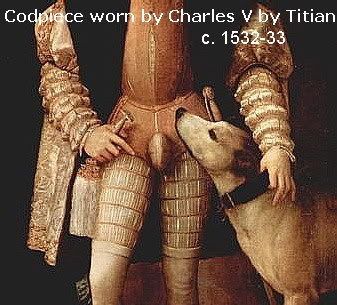
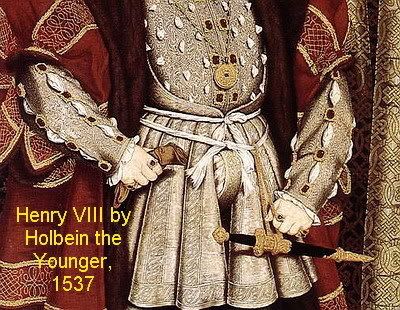

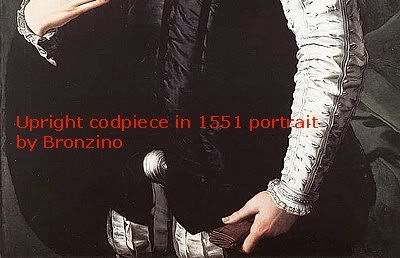
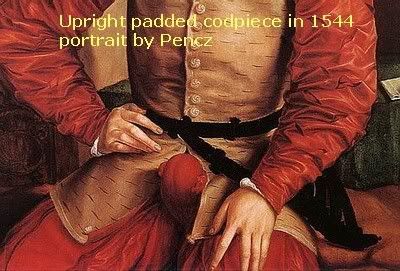
Detail from Giovanni Battista Moroni's portrait of Antonio Navagero, 1565:
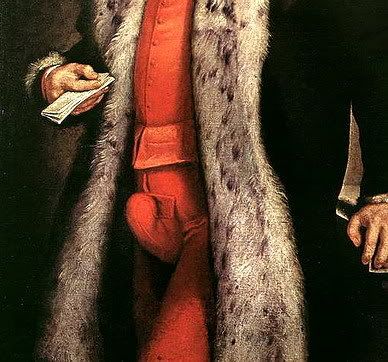
Here’s an interesting snippet on the codpiece (larger article here):
Codpiece - Codd in old English is the word for bag. The origin of the codpiece is under some debate. Some say it came to England by way of Italian Duke Fabrizio of Bologna (well-known for being well-endowed). The rumor is King Henry VIII ordered his Codpieces enlarged after his wife, at the moment, Queen Anne Boleyn said what we thought Mae West was popular for saying. "Be that thine codling, or art thou glad to see me?"
Early cod pieces were a simple triangle buttoned [tied, more likely] at the top on either side to hold in the male anatomy. As the Codpiece became a fashion statement not just a necessity they became ridiculously elaborate. Codpieces were often padded and highly decorative. Eventually men started to use them as a pouch to hold coin and such. This is where the term “The Family Jewels” finds its origin.
After the codpiece era, the skirts of tunics dropped and men’s pieces were no longer on public display. During the early and mid-18th century, men wore breeches buckled below the knee that fit well, but with plenty of room behind the front placket and in the seat, to tuck in voluminous shirts. But the crotch portion was not on view. Over the close-legged breeches a long-fronted waistcoat was worn. Over that, a jacket.
Not every 18th century man wore braies, however, making do by tucking the long shirt tails around himself, front and back. But underwear that was worn followed the line of the breeches (more often fastening at the waist, with drawstrings, than buttons as shown below):
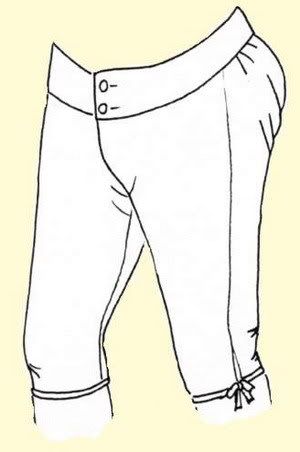
Here is a detail from a painting of a tryst in progress by Fragonard, “Le Verrou” (“The Bolt”), painted in 1777-78. The man is down to what then would be entirely underwear (being in shirt-sleeves counted as underwear): a billowing shirt is tucked into fine drawstring braies. He’s already without his shoes, stockings, jacket, waistcoat, neck cloth, and breeches.
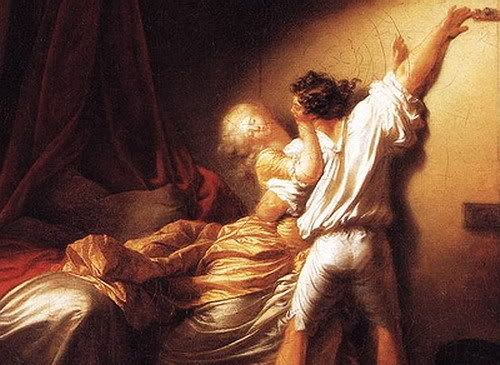
To see the full painting, click HERE.
Men’s crotches became very viewable again in the classical revival, beginning in the late 18th century, when everyone fashionable wished to look like newly-excavated Roman and Greek statues of gods and goddesses. For women, it meant the decline of wide skirts and multi-layers of petticoats beneath them, long corsets, and a good deal of coverage generally. For men, at first, it was merely a matter of taking up the waistcoat, so that the front of the breeches showed. Otherwise, the cloth thickness and fit was still very like that of the previous decade. Below is a still of Hugh Grant wearing breeches with a buttoned frontfall (placket), from Sense and Sensibility, set in the latter half of the 1790’s.

In the images painted by Louis-Leopold Bouilly below, it’s the next decade. The first is a self-portrait, showing a cutaway jacket and waistcoat, with tan breeches, but the fit of the pants is still not tight.
Below that is a portrait by Bouilly of young Francois Boieldieu, wearing the latest skin-tight, flesh-toned breeches.
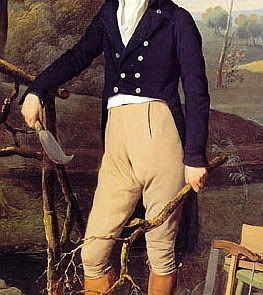
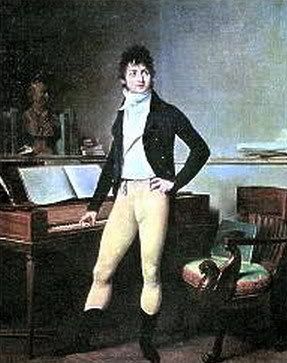
The naked, Greek-statue-look was all the rage for several years. For men with great bodies, it was a fabulous era. But, perhaps, never in fashion history was there an era of men’s clothing more unforgiving to a man with a less than ideal physique. If the 16th century loved an erect phallus, the early 19th loved an erect torso. Stomachers were worn by men to flatten their stomachs, but that didn’t do nearly enough for most, I suspect. As we know from our recent era of women’s fashions, tight, clingy clothes enhance the bodies of those who are in perfect shape, but reveal the imperfections of those who are not.
Underwear? Judging from the painting of Mr. Boieldieu, and the 1817 painting below by Pierre Narcisse Guerin, of Henri de la Rochejaquelin leading the revolt in the Vendee, fashionable men might not have worn wear any. If they did, the garments would have to have had an extremely close fit, made of very thin stuff.
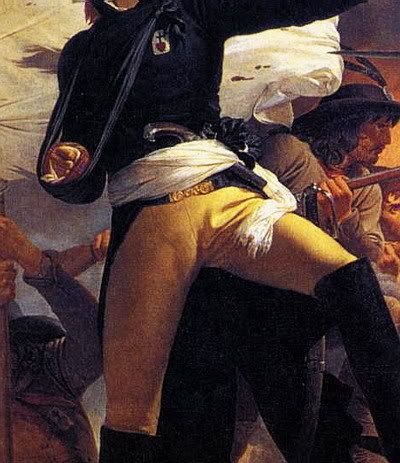
Under such breeches, the slightest crease or seam would show-as did everything else. As I said, a very interesting age in which to live.
Here is Monsieur de Nogent wearing a similar pair of clingy, pale, tight breeches, painted by Ingres, 1815:
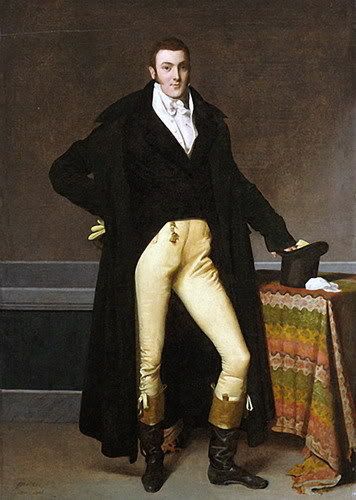
Section II. More thoughts on the Codpiece-look, or Bulge.
I had already written most of the material above when I posted Part I, but a lead from yeuxdebleu gave me the opportunity to put more thought into the matter of the male bulge and its fashions. She linked me to the amusing, and amazing, Bulge Research Institute, which in turn pointed me (ha) to EBulges.
Ebulges* has hundreds of files to look at, if someone has the inclination to browse them all. Even I got tired of scrolling through columns and columns of every sort of male showing off every sort of bulge.
After all, I was looking for illustrations that would compare underwear designs. It was difficult to make comparisons when some images showed men with erections, or semi-erections, and other images showed men in their flaccid state (it was not always easy to tell in the Wonderbra models). Comparing penises that are erect to penises that are not is like comparing green beans to zucchinis. When it comes to size, zucchinis best green beans every time.
There were other links at the “Bulge Research Institute”, which I didn’t spend as much time browsing. The EBulge site was for clothed crotches, which was just what I was looking for, researching underwear. But the associated links specialized in other things. Some specialized in uncircumcised men, some in older men. One featured men’s bulges as seen in beach settings. Others promised glimpses of especially huge-membered men.
For me, the most thought-provoking specialty-bulge gallery featured photos of men whose testicles were notably large, housed in pendulous scrotums. After viewing a dozen images from the site, I began to think I was at a county fair. I expected a tweedy arm wielding a walking stick to appear in the picture, poking and prodding the goods to check out the heft and sway, commenting knowledgeably, “Aye, Angus. This one’s sure to sire some fine progeny.” I wondered if I hadn’t inadvertently clicked open a site for stud sheep or cattle.
Comparable specimens: stud bulls and rams.

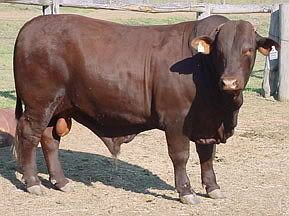
* I was astonished, I should note, even in this show-and-tell era, at the sheer number and variety of the photos on EBulge. Most of them were taken of “regular” men. Few images showed a face, yet I still was amazed that so many men would put their photographs on the site. I thought it funny, yes, but also an indicator of how content men are with their bodies and genitals generally. Every sort of body appeared in the images: fit, soft, skinny, fat, teenaged, elderly, shaved, hairy, laughably little, and impressively huge. There were beautiful bulges, and bulges nearly deformed and monstrous; flaccid members, and penises flamboyantly erect. I can’t imagine women doing this. Not because they’re shyer, necessarily, but because so few women think their bodies or genitals are worth looking at. Men seem to just love what they’ve got, whatever it is. I think that aspect of their exhibitionism rather enviable.
I digress, but only slightly. As I said, I gave the site a perusal (of course), but, as I did, it occurred to me how much the total bulge a man is able to muster depends on the size and hang of his testicles. If his testicles are pendulous, and if he wears loose boxers or pants, they may languish unnoticed. But, gathered up into a pouch (or c-ring/sling/o-ring), his testicles can provide the platform on which the penis-even if it is small-sits in prominence, rather like a sceptre laying upon a ceremonial pillow. The plumper the pillow, the higher the sceptre sits.
This, I decided, was what made all the “pull up and project forward” underwear devices work. In an exaggerated fashion, they simulated what drawn-up testicles do, making the penis look more “perky” because of its jauntier angle sitting atop the high-gathered, plumped-up testicles.
Even “little fellows” can convey this look. Art critics of Michelangelo’s David (often tittered over as a little fellow) sometimes have noted that the marble hero has drawn-up testicles-the result of “fight-or-flight” pre-conflict excitement. Thus, from the front, David’s penis looks especially small because it is foreshortened. From the side (although his is still a modest [if perfect] member), it is clear that his penis is borne up at an angle by his relatively drawn-up testicles.


What is the appeal of the accentuated “up” look in modern men’s underwear?-other than the obvious one of sexual readiness? A penis that is fully “up” is what the most extreme codpieces of the 16th century emulated. Yet as wild as the style was, otherwise staid, important public figures wore it.
I have begun to think that these men didn’t just want to look big-or even sexy-as much as they wanted to look like men to be reckoned with. Men with fire in their minds and spirits, not just their groins-but which their potent-looking groins stood for. The testicles of an excited man, whether from sudden desire or the adrenalin that comes from fear or tension at the threat of conflict, draw up closer to the body. Apart from whether the penis is erect, the overall “look” is that of a man ready for action. “Up”, “high”, “ready”, and “rarin’ to go” are expressions that carry all sorts of associations, not just sexual ones. Being “ready for action”, “full of ardour”, “aflame with passion”, and “full of daring” are all attributes of the hero-the commander, the innovator, the leader-not just the lover: .
No wonder 16th century monarchs posed for state portraits wearing these high-rearing, projecting phalluses. They, too, wanted to look bold, forceful, forthright and full of fervour. This, I think, is the essence of the codpiece look of yore-it was not merely considered sexy, but the symbol of everything competent, courageous, and bold.
Yet there is another “look” that prominent male bulges can convey-that is, other than ‘ready for action’, and ‘once more into the breech’. This other sort of genital prominence conveys more a sense of rich resources, and, perhaps, a greater sensuality. This is the look of luxuriously pendant genitals. As opposed to the erect look, in which the penis is the star and leader of the charge, the full, ripe look implies someone with deep reserves.
Sometimes the expression, “That was ballsy!”, or “That guy has balls!” commends daring or risky behaviour. Yet saying “that guy has balls” can also mean that the speaker finds the person worthy as a man: a person with strength and staying power, a person with the resources to back up the opening charge. “Balls” implies an ongoing reserve of character and energy beyond the first passionate assault. Concentrating on the jutting codpiece, I had forgotten how much impact sheer, solid voluptuousness can have.
The pendulous look in genitals implies reserves but also a sense of leisure-as if the possessor of such genitals can take his time. There's a look of lushness, languor; ripeness. These are genitals like fruit that hangs from vine and branch to be held and tested, plucked, and savoured.
Estë remarked that the William Morris background for my journal was chock-full of sensual imagery-small but luscious fruit, ripe to bursting, round and ovoid. I hadn’t noticed the detail, choosing it for its overall hue and look, but she’s right. I do love what the imagery implies (for me): potency, fecundity (physical and non-physical), and a lush sensuality.
There has long been underwear, such as the loincloth or the traditional hang-low jock strap, and some modern low-slung pouch-style underwear, that accentuates this look. With this look, it’s less a matter of “bulge” than “hang”. The impetuosity and daring of the ‘codpiece look’ impresses, and makes me ogle, but the ‘pendulous fruit’ look invites me to come closer: to touch, to be intimate.
To return briefly to the original topic (how EW might portray Iggy Pop in the package department), Iggy’s nude photo falls in the “hanging fruit” category. He doesn't bulge, but hangs. His penis has the slightest lift from the testicles behind, hidden in the shadows, but probably set low since they don't create "the lifeguard lift" (don't know if it's the cold water or what, but a lot of lifeguards in my day seemed to have had some version of the "David" genitals: a penis resting at a jaunty angle atop a mound of high-set testicles).
The "lifeguard lift":
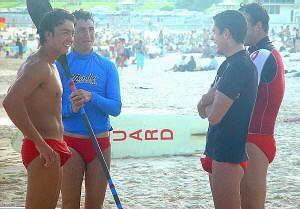
With this in mind, I don't see how Iggy's look could be approximated with either c-ring or structured pouch underwear. Iggy, who went underwear-less, has a very natural look. There is none of the pokey-pointy-bulgy-thing going on. Whoever played him would have to wear no underwear, or what looked like no underwear. No man-bras.

Aesthetics.
There really is quite a difference between the “up” and “let-it-hang” look. I will try to show the difference in the images below, in which the same [very big] man wears different underwear. The first image shows him wearing racy but unstructured hi-cut briefs. He appears to have large testicles, and a medium-to-large penis. The fundamental effect his genitals make in this soft cloth pouch is one of plenitude, but not excess.
On another page, I found two images of the same man, but wearing briefs utilizing c-rings assists. These garments lift his genitals up and forward. He does look bigger, but his ripe, fruitful look is transformed into a projecting codpiece. It really is quite a different effect. Personally, I much prefer the natural look, however eye-popping his enhanced super-bulge.
Tattooed man with plain support briefs:

Same man in thong and briefs with c-rings:


Below is a photograph by Wilhelm von Gloeden. This 19th century artist is famous today for his images of nude men and boys made while in Sicily (the services of these comely Italian working men and boys were cheap). Some are erotic, but most have an artistic, elegiac tone. He typically posed his subjects as if for a painting or sculpture, and his photos were used by other artists as bases for their paintings.
The photograph below demonstrates the difference between the two “looks” I've been talking about, but on young men of normal proportions, unassisted by special underwear or appliances. The youth on the left has the high-set testicles of the Michelangelo 'David', his penis lying atop his testicles nearly perpendicular to the ground. This is the realistically proportioned version of what the “projecting package” underwear tries to do-but on a much grander scale. The penis of the youth on the right, on the other hand, hangs nearly straight down, implying low-slung testicles behind them. He demonstrates what I've been calling the "pendulous fruit" model.
I think both these models are wonderful. They could have stepped out of ancient Roman or Greek frescos. No wonder van Gloeden wanted to paint them. With their earth-stained feet and calves, one could even pretend they're furry, like fauns-or hobbits.

It occurred to me that the youth on the right could represent the the no-underwear look of 70's rock-and-rollers, the guys of Iggy’s era.
That rock fans were ogling the bulges under the jeans of 70’s rock stars was made clear in the hilarious “mockumentary” by Rob Reiner, made in 1984, spoofing heavy metal bands and their sexual flamboyance. This is Spinal Tap is about a fictional rock band that is on the downside of its career. Interestingly, the three band members are played by the same actors (Christopher Guest, Michael McKeen and Harry Shearer) who played the folk trio in Christopher Guest’s 2003 mockumentary, A Mighty Wind.
Here’s a still from a memorable scene:
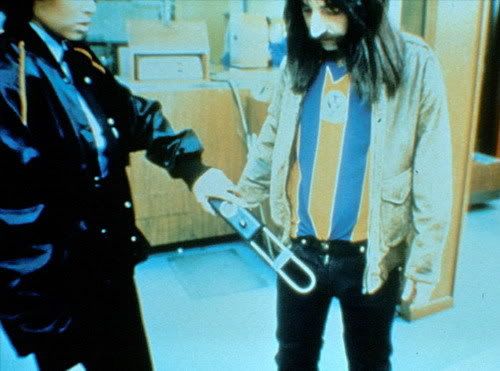
In this scene, Harry Shearer’s character is stopped, going through the metal detector at the airport. The attendant wands him, and registers trouble in his pant leg. Harry is made to unzip, revealing a large cucumber wrapped in aluminium foil, his home-made rock-star prosthetic.
Section III. Codpiece flights of fancy.
Another thing. While looking at hundreds of examples of men displaying themselves in every sort of hidden-structured or contour-pouched underwear, I couldn't help thinking of things they reminded me of. The more aggressively the underwear “lifted and projected forward”, the more implausible, fanciful, or grotesque the profiles.
Some were so large and bulbous, the ends of their penises curving over the uplifted package, I was reminded of the proboscis of Groucho Marx, or of a bull elephant seal.
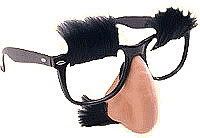
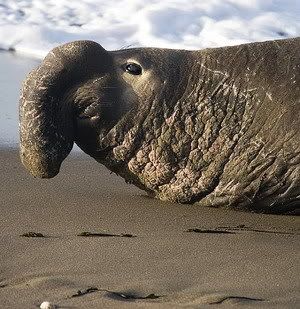





Others reminded me of the beaks of birds. Here is the Toucan look:



Honk for the Canada goose:


Ones like flamingos (or like the nose of Punch):
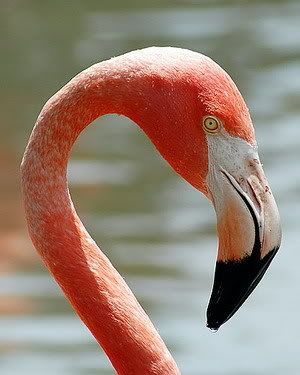
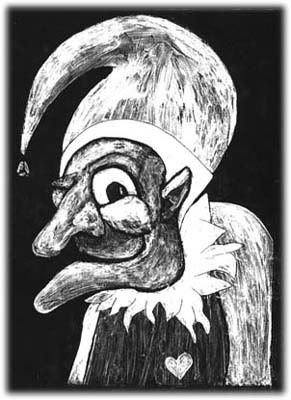
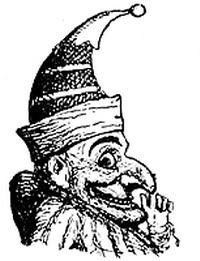


Smaller, pointier fellows, like hummingbirds:


Last (and least, bless them), the little chickadees of the bulge world:
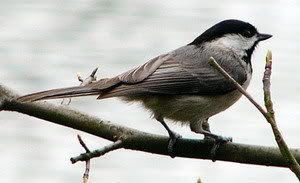



As the last group demonstrates, *every* man seems to think well of his bulge, no matter what its dimensions.
~*~
Well, that’s it, really. Below I’m just going to post a few special selections that I thought memorable.
For just_ann_now: this might be what the Men of Gondor were wearing under their tunics (note built-in contour pouch)....

And here’s what the "Cruel Haradrim" were wearing:

Here’s what the healers in the Houses of Healing had under their robes:

~*~
And that’s all for the Codpiece Extravaganza. I have spent FAR too many days putting this together, but it’s been illuminating and fun.
In the meantime, I hope to catch up on all the journals of friends I've been missing while I've been working on this. My next post, when it appears, will return to the regularly-scheduled programming (Frodo screencaps).
~ Mechtild
Previous entry: "Wonderbras for Men Pt. I" HERE.
Notes: Still sure to offend some, and still rated Mature for explicit talk of "packages", images of racy men's underwear, nude Michelangelo’s David, nude Iggy again, and a Victorian photograph of nude men.
Again, there are loads of images to plague dial-up viewers. Images in this post are NOT links (so don’t wear out your clicking finger trying to make the guys bigger).
The first section will survey the history of men’s underwear, continuing with the discussion of the way underwear presents men’s genitals.
Section I. [European] Men’s Underwear.
In antiquity, Roman and Greek men, if they wore underwear at all, wore something of the loin cloth variety. Very little antique underwear exists even from more recent centuries, the garments passed on until they wore out and became rags. But, by the Middle Ages, judging from surviving texts and illustrations, women were wearing shifts* and men were wearing underdrawers, braies, from which came “breeches”.
*Women’s drawers wear not worn until the early 19th century, prompted by the clingy, form-fit style of Empire fashion. These were truly drawers, the pant legs open at the crotch for accessibility when using the toilet. Drawers continued to be open at the crotch for most of the 19th century, partially explaining the scandal of the can-can.
Medieval braies of the 13th century looked like boxer shorts, falling to the knee, with drawstring waists, which were then rolled a few times for comfort, and to bring the crotch to the right level. The inseams, except for the part near the crotch, were finished off open. This is clearly seen in prints.
The advantages of this were several. When peeing, the split inseam allowed a man to pull out his penis without taking down the braies. The split inseams also meant the man could wrap the leg panels more closely over his upper legs before tucking them down into his hose. A better fit in the legs meant there wasn’t a lot of excess linen hanging out of the tops of the hose.
The hose were tied to laces on the waistbands of the braies. Working outside in hot weather, stripped to their braies, men could tie up the ends of the legs with the laces at the waist, making the braies as short as they wished.
Braies have continued to be worn little changed ever since. Frodo, in the Cirith Ungol scene, appears to be wearing linen braies, the drawstring waist just visible above his breeches. That would make sense, since it is noted in the book that Sam, making sure he has plenty of everything, has packed "extra linen", ready to be produced when called for [by Frodo]. That could mean shirts, but in the scene in which Frodo's Moria wound is dressed, he's wearing a jacket over his worn tunic, under which is the mithril corselet. Under that is a shirt of soft leather worn next to the skin. No mention is made of additional linen in this detailed desciption of his upper clothing, so I am assuming the "extra linen" refers to braies.
Here are some illustrations showing the split-inseamed braies, worn alone, or tucked into split hose.




Replicas of split hose with braies tucked in, hose tied to doublet:

Braies were not always worn in the 13th century, an era when men’s tunics were well below the knee. This blown-up tiny image comes from a Book of Hours, showing a peasant man and woman warming themselves before the fire. They are quite naked under their clothes.

As the years went on, fashions changed. Men’s tunics became shorter. And shorter. Underneath, there was no fabric covering the crotch except the braies. If the man did not wear braies, he was naked above his hose.
I found the fascinating historical note below here.
Late-14th c fashions for dandies raised the hemlines to the ballocks, and early 15th c saw the first public exposure of the male crotch beneath the tunic. This trend forced the chaussers to invent the one-piece or joined hose. There is a turn-of-the-century admonition by an English bishop against men who sit splay-legged, exposing themselves; the implication is that they have purposefully chosen to omit wearing braies for shock value, but it may merely indicate outrage at the public display of the underpants.
At this point or soon after, the joined hose are no longer tied to the waistband, as mentioned above.
It should be noted that the rise of joined hosen did not eradicate the older, simpler style of separate hosen. As late as 1460 there is clear evidence in manuscripts of separate hosen worn by a member of the middle class. Obviously joined hosen, with the difficulties in tailoring and susceptability to bursting at the seat seams, were unpractical for the laboring class altogether.
Between the 14th and 15th century fashionable hose began to be made joined from the crotch to the back, but open in the front (for convenience), covered by a triangular panel, essentially a fly. Also, as more and more leg was being seen, even the buttocks, the braies became smaller and more fitted.
Here are some 14th and 15th century braies, also some joined hose with the front panel (historical replica).



The image below shows split hose tied to a doublet, braies beneath. It was not dated, but I’m guessing it’s just before joined hose became the style. The 15th century split hose in the photo of historical replicas above are also tied to a doublet, so I will assume this image is from the 15th century.

The triangular piece covering the crotch eventually came into general use.

When tunic hems rose higher than the triangular piece, it began to receive fashionable attention. It might be trimmed, or be made of a contrasting colour. The pieces might have been sewn in a manner that made them more pouch-like, too. Already hose and braies had long been cut on the bias for better, closer fit. The ones pictured below seem to have a snug, supportive fit:

In this 15th century Renaissance painting, the cloth codpieces do seem to have had a pouch-like shape, very much like the “contour pouch”-style underwear I posted yesterday. Any braies worn under such close-fitting hose had to fit well, unlike the big, loose-fitting braies of previous centuries.
Modern equivalents of "soft codpiece" underwear (the last, I suspect, has a c-ring device):



With the 16th century came the true “codpiece” - a structured cover for the penis and scrotum, resembling an athletic cup to start with, growing to a stiff, cotton-stuffed erection by mid-century.
Here are some examples from art:





Detail from Giovanni Battista Moroni's portrait of Antonio Navagero, 1565:

Here’s an interesting snippet on the codpiece (larger article here):
Codpiece - Codd in old English is the word for bag. The origin of the codpiece is under some debate. Some say it came to England by way of Italian Duke Fabrizio of Bologna (well-known for being well-endowed). The rumor is King Henry VIII ordered his Codpieces enlarged after his wife, at the moment, Queen Anne Boleyn said what we thought Mae West was popular for saying. "Be that thine codling, or art thou glad to see me?"
Early cod pieces were a simple triangle buttoned [tied, more likely] at the top on either side to hold in the male anatomy. As the Codpiece became a fashion statement not just a necessity they became ridiculously elaborate. Codpieces were often padded and highly decorative. Eventually men started to use them as a pouch to hold coin and such. This is where the term “The Family Jewels” finds its origin.
After the codpiece era, the skirts of tunics dropped and men’s pieces were no longer on public display. During the early and mid-18th century, men wore breeches buckled below the knee that fit well, but with plenty of room behind the front placket and in the seat, to tuck in voluminous shirts. But the crotch portion was not on view. Over the close-legged breeches a long-fronted waistcoat was worn. Over that, a jacket.
Not every 18th century man wore braies, however, making do by tucking the long shirt tails around himself, front and back. But underwear that was worn followed the line of the breeches (more often fastening at the waist, with drawstrings, than buttons as shown below):

Here is a detail from a painting of a tryst in progress by Fragonard, “Le Verrou” (“The Bolt”), painted in 1777-78. The man is down to what then would be entirely underwear (being in shirt-sleeves counted as underwear): a billowing shirt is tucked into fine drawstring braies. He’s already without his shoes, stockings, jacket, waistcoat, neck cloth, and breeches.

To see the full painting, click HERE.
Men’s crotches became very viewable again in the classical revival, beginning in the late 18th century, when everyone fashionable wished to look like newly-excavated Roman and Greek statues of gods and goddesses. For women, it meant the decline of wide skirts and multi-layers of petticoats beneath them, long corsets, and a good deal of coverage generally. For men, at first, it was merely a matter of taking up the waistcoat, so that the front of the breeches showed. Otherwise, the cloth thickness and fit was still very like that of the previous decade. Below is a still of Hugh Grant wearing breeches with a buttoned frontfall (placket), from Sense and Sensibility, set in the latter half of the 1790’s.

In the images painted by Louis-Leopold Bouilly below, it’s the next decade. The first is a self-portrait, showing a cutaway jacket and waistcoat, with tan breeches, but the fit of the pants is still not tight.
Below that is a portrait by Bouilly of young Francois Boieldieu, wearing the latest skin-tight, flesh-toned breeches.


The naked, Greek-statue-look was all the rage for several years. For men with great bodies, it was a fabulous era. But, perhaps, never in fashion history was there an era of men’s clothing more unforgiving to a man with a less than ideal physique. If the 16th century loved an erect phallus, the early 19th loved an erect torso. Stomachers were worn by men to flatten their stomachs, but that didn’t do nearly enough for most, I suspect. As we know from our recent era of women’s fashions, tight, clingy clothes enhance the bodies of those who are in perfect shape, but reveal the imperfections of those who are not.
Underwear? Judging from the painting of Mr. Boieldieu, and the 1817 painting below by Pierre Narcisse Guerin, of Henri de la Rochejaquelin leading the revolt in the Vendee, fashionable men might not have worn wear any. If they did, the garments would have to have had an extremely close fit, made of very thin stuff.

Under such breeches, the slightest crease or seam would show-as did everything else. As I said, a very interesting age in which to live.
Here is Monsieur de Nogent wearing a similar pair of clingy, pale, tight breeches, painted by Ingres, 1815:

Section II. More thoughts on the Codpiece-look, or Bulge.
I had already written most of the material above when I posted Part I, but a lead from yeuxdebleu gave me the opportunity to put more thought into the matter of the male bulge and its fashions. She linked me to the amusing, and amazing, Bulge Research Institute, which in turn pointed me (ha) to EBulges.
Ebulges* has hundreds of files to look at, if someone has the inclination to browse them all. Even I got tired of scrolling through columns and columns of every sort of male showing off every sort of bulge.
After all, I was looking for illustrations that would compare underwear designs. It was difficult to make comparisons when some images showed men with erections, or semi-erections, and other images showed men in their flaccid state (it was not always easy to tell in the Wonderbra models). Comparing penises that are erect to penises that are not is like comparing green beans to zucchinis. When it comes to size, zucchinis best green beans every time.
There were other links at the “Bulge Research Institute”, which I didn’t spend as much time browsing. The EBulge site was for clothed crotches, which was just what I was looking for, researching underwear. But the associated links specialized in other things. Some specialized in uncircumcised men, some in older men. One featured men’s bulges as seen in beach settings. Others promised glimpses of especially huge-membered men.
For me, the most thought-provoking specialty-bulge gallery featured photos of men whose testicles were notably large, housed in pendulous scrotums. After viewing a dozen images from the site, I began to think I was at a county fair. I expected a tweedy arm wielding a walking stick to appear in the picture, poking and prodding the goods to check out the heft and sway, commenting knowledgeably, “Aye, Angus. This one’s sure to sire some fine progeny.” I wondered if I hadn’t inadvertently clicked open a site for stud sheep or cattle.
Comparable specimens: stud bulls and rams.


* I was astonished, I should note, even in this show-and-tell era, at the sheer number and variety of the photos on EBulge. Most of them were taken of “regular” men. Few images showed a face, yet I still was amazed that so many men would put their photographs on the site. I thought it funny, yes, but also an indicator of how content men are with their bodies and genitals generally. Every sort of body appeared in the images: fit, soft, skinny, fat, teenaged, elderly, shaved, hairy, laughably little, and impressively huge. There were beautiful bulges, and bulges nearly deformed and monstrous; flaccid members, and penises flamboyantly erect. I can’t imagine women doing this. Not because they’re shyer, necessarily, but because so few women think their bodies or genitals are worth looking at. Men seem to just love what they’ve got, whatever it is. I think that aspect of their exhibitionism rather enviable.
I digress, but only slightly. As I said, I gave the site a perusal (of course), but, as I did, it occurred to me how much the total bulge a man is able to muster depends on the size and hang of his testicles. If his testicles are pendulous, and if he wears loose boxers or pants, they may languish unnoticed. But, gathered up into a pouch (or c-ring/sling/o-ring), his testicles can provide the platform on which the penis-even if it is small-sits in prominence, rather like a sceptre laying upon a ceremonial pillow. The plumper the pillow, the higher the sceptre sits.
This, I decided, was what made all the “pull up and project forward” underwear devices work. In an exaggerated fashion, they simulated what drawn-up testicles do, making the penis look more “perky” because of its jauntier angle sitting atop the high-gathered, plumped-up testicles.
Even “little fellows” can convey this look. Art critics of Michelangelo’s David (often tittered over as a little fellow) sometimes have noted that the marble hero has drawn-up testicles-the result of “fight-or-flight” pre-conflict excitement. Thus, from the front, David’s penis looks especially small because it is foreshortened. From the side (although his is still a modest [if perfect] member), it is clear that his penis is borne up at an angle by his relatively drawn-up testicles.


What is the appeal of the accentuated “up” look in modern men’s underwear?-other than the obvious one of sexual readiness? A penis that is fully “up” is what the most extreme codpieces of the 16th century emulated. Yet as wild as the style was, otherwise staid, important public figures wore it.
I have begun to think that these men didn’t just want to look big-or even sexy-as much as they wanted to look like men to be reckoned with. Men with fire in their minds and spirits, not just their groins-but which their potent-looking groins stood for. The testicles of an excited man, whether from sudden desire or the adrenalin that comes from fear or tension at the threat of conflict, draw up closer to the body. Apart from whether the penis is erect, the overall “look” is that of a man ready for action. “Up”, “high”, “ready”, and “rarin’ to go” are expressions that carry all sorts of associations, not just sexual ones. Being “ready for action”, “full of ardour”, “aflame with passion”, and “full of daring” are all attributes of the hero-the commander, the innovator, the leader-not just the lover: .
No wonder 16th century monarchs posed for state portraits wearing these high-rearing, projecting phalluses. They, too, wanted to look bold, forceful, forthright and full of fervour. This, I think, is the essence of the codpiece look of yore-it was not merely considered sexy, but the symbol of everything competent, courageous, and bold.
Yet there is another “look” that prominent male bulges can convey-that is, other than ‘ready for action’, and ‘once more into the breech’. This other sort of genital prominence conveys more a sense of rich resources, and, perhaps, a greater sensuality. This is the look of luxuriously pendant genitals. As opposed to the erect look, in which the penis is the star and leader of the charge, the full, ripe look implies someone with deep reserves.
Sometimes the expression, “That was ballsy!”, or “That guy has balls!” commends daring or risky behaviour. Yet saying “that guy has balls” can also mean that the speaker finds the person worthy as a man: a person with strength and staying power, a person with the resources to back up the opening charge. “Balls” implies an ongoing reserve of character and energy beyond the first passionate assault. Concentrating on the jutting codpiece, I had forgotten how much impact sheer, solid voluptuousness can have.
The pendulous look in genitals implies reserves but also a sense of leisure-as if the possessor of such genitals can take his time. There's a look of lushness, languor; ripeness. These are genitals like fruit that hangs from vine and branch to be held and tested, plucked, and savoured.
Estë remarked that the William Morris background for my journal was chock-full of sensual imagery-small but luscious fruit, ripe to bursting, round and ovoid. I hadn’t noticed the detail, choosing it for its overall hue and look, but she’s right. I do love what the imagery implies (for me): potency, fecundity (physical and non-physical), and a lush sensuality.
There has long been underwear, such as the loincloth or the traditional hang-low jock strap, and some modern low-slung pouch-style underwear, that accentuates this look. With this look, it’s less a matter of “bulge” than “hang”. The impetuosity and daring of the ‘codpiece look’ impresses, and makes me ogle, but the ‘pendulous fruit’ look invites me to come closer: to touch, to be intimate.
To return briefly to the original topic (how EW might portray Iggy Pop in the package department), Iggy’s nude photo falls in the “hanging fruit” category. He doesn't bulge, but hangs. His penis has the slightest lift from the testicles behind, hidden in the shadows, but probably set low since they don't create "the lifeguard lift" (don't know if it's the cold water or what, but a lot of lifeguards in my day seemed to have had some version of the "David" genitals: a penis resting at a jaunty angle atop a mound of high-set testicles).
The "lifeguard lift":

With this in mind, I don't see how Iggy's look could be approximated with either c-ring or structured pouch underwear. Iggy, who went underwear-less, has a very natural look. There is none of the pokey-pointy-bulgy-thing going on. Whoever played him would have to wear no underwear, or what looked like no underwear. No man-bras.

Aesthetics.
There really is quite a difference between the “up” and “let-it-hang” look. I will try to show the difference in the images below, in which the same [very big] man wears different underwear. The first image shows him wearing racy but unstructured hi-cut briefs. He appears to have large testicles, and a medium-to-large penis. The fundamental effect his genitals make in this soft cloth pouch is one of plenitude, but not excess.
On another page, I found two images of the same man, but wearing briefs utilizing c-rings assists. These garments lift his genitals up and forward. He does look bigger, but his ripe, fruitful look is transformed into a projecting codpiece. It really is quite a different effect. Personally, I much prefer the natural look, however eye-popping his enhanced super-bulge.
Tattooed man with plain support briefs:

Same man in thong and briefs with c-rings:


Below is a photograph by Wilhelm von Gloeden. This 19th century artist is famous today for his images of nude men and boys made while in Sicily (the services of these comely Italian working men and boys were cheap). Some are erotic, but most have an artistic, elegiac tone. He typically posed his subjects as if for a painting or sculpture, and his photos were used by other artists as bases for their paintings.
The photograph below demonstrates the difference between the two “looks” I've been talking about, but on young men of normal proportions, unassisted by special underwear or appliances. The youth on the left has the high-set testicles of the Michelangelo 'David', his penis lying atop his testicles nearly perpendicular to the ground. This is the realistically proportioned version of what the “projecting package” underwear tries to do-but on a much grander scale. The penis of the youth on the right, on the other hand, hangs nearly straight down, implying low-slung testicles behind them. He demonstrates what I've been calling the "pendulous fruit" model.
I think both these models are wonderful. They could have stepped out of ancient Roman or Greek frescos. No wonder van Gloeden wanted to paint them. With their earth-stained feet and calves, one could even pretend they're furry, like fauns-or hobbits.

It occurred to me that the youth on the right could represent the the no-underwear look of 70's rock-and-rollers, the guys of Iggy’s era.
That rock fans were ogling the bulges under the jeans of 70’s rock stars was made clear in the hilarious “mockumentary” by Rob Reiner, made in 1984, spoofing heavy metal bands and their sexual flamboyance. This is Spinal Tap is about a fictional rock band that is on the downside of its career. Interestingly, the three band members are played by the same actors (Christopher Guest, Michael McKeen and Harry Shearer) who played the folk trio in Christopher Guest’s 2003 mockumentary, A Mighty Wind.
Here’s a still from a memorable scene:

In this scene, Harry Shearer’s character is stopped, going through the metal detector at the airport. The attendant wands him, and registers trouble in his pant leg. Harry is made to unzip, revealing a large cucumber wrapped in aluminium foil, his home-made rock-star prosthetic.
Section III. Codpiece flights of fancy.
Another thing. While looking at hundreds of examples of men displaying themselves in every sort of hidden-structured or contour-pouched underwear, I couldn't help thinking of things they reminded me of. The more aggressively the underwear “lifted and projected forward”, the more implausible, fanciful, or grotesque the profiles.
Some were so large and bulbous, the ends of their penises curving over the uplifted package, I was reminded of the proboscis of Groucho Marx, or of a bull elephant seal.







Others reminded me of the beaks of birds. Here is the Toucan look:



Honk for the Canada goose:


Ones like flamingos (or like the nose of Punch):





Smaller, pointier fellows, like hummingbirds:


Last (and least, bless them), the little chickadees of the bulge world:




As the last group demonstrates, *every* man seems to think well of his bulge, no matter what its dimensions.
~*~
Well, that’s it, really. Below I’m just going to post a few special selections that I thought memorable.
For just_ann_now: this might be what the Men of Gondor were wearing under their tunics (note built-in contour pouch)....

And here’s what the "Cruel Haradrim" were wearing:

Here’s what the healers in the Houses of Healing had under their robes:

~*~
And that’s all for the Codpiece Extravaganza. I have spent FAR too many days putting this together, but it’s been illuminating and fun.
In the meantime, I hope to catch up on all the journals of friends I've been missing while I've been working on this. My next post, when it appears, will return to the regularly-scheduled programming (Frodo screencaps).
~ Mechtild
Previous entry: "Wonderbras for Men Pt. I" HERE.